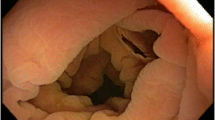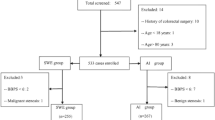Abstract
Background
The aim of this meta-analysis was to determine whether water infusion colonoscopy (WIC) is a more effective diagnostic tool than standard air insufflation colonoscopy (AIC).
Methods
All articles pertinent to a comparison of water-related methods and air insufflation to facilitate insertion of the colonoscope were retrieved from PubMed, Web of Science, Embase, and Cochrane databases. Pooling results were derived by using the Review Manager Software. Outcomes were assessed using the weighted mean difference (MD) with 95 % confidence intervals (CI) for continuous variables and the odds ratios (OR) with 95 % CI for dichotomous variables.
Results
Eighteen studies involving 2,797 patients were included. WIC was associated with a significantly higher cecal intubation rate than AIC (OR = 1.90; 95 % CI 1.21–2.99; p = 0.005). The intubation time was similar for the two types of colonoscopy, but in WIC there was a significantly lower visual analog scale score for abdominal pain than in AIC (MD = −1.30; 95 % CI −2.03 to −0.58; p < 0.001) without sacrificing the polyp detection rate (OR = 1.17; 95 % CI 0.78–1.77; p = 0.44). Statistically, the patient’s willingness to repeat colonoscopy was significantly greater for WIC than for AIC (OR = 1.74; 95 % CI 1.14–2.67; p < 0.01). Furthermore, in the subgroup for trainees, the WIC group achieved a higher cecal intubation rate (OR = 1.83; 95 % CI 1.15–2.93; p = 0.01) and a shorter intubation time (MD = −1.72 min; 95 % CI −3.34 to −0.11; p = 0.04) than the AIC group.
Conclusions
In contrast to AIC, WIC improved cecal intubation, alleviated abdominal pain, and increased patients’ willingness to repeat the procedure.







Similar content being viewed by others
References
Jemal A, Bray F, Center MM, Ferlay J, Ward E, Forman D (2011) Global cancer statistics. CA Cancer J Clin 61:69–90
Edwards BK, Ward E, Kohler BA et al (2010) Annual report to the nation on the status of cancer, 1975–2006, featuring colorectal cancer trends and impact of interventions (risk factors, screening, and treatment) to reduce future rates. Cancer 116:544–573
Lindsay DC, Freeman JG, Cobden I et al (1988) Should colonoscopy be the first investigation for colonic disease. Br Med J (Clin Res Ed) 296:167–169
Waye JD, Bashkoff E (1991) Total colonoscopy: is it always possible. Gastrointest Endosc 37:152–154
Leung FW (2008) Methods of reducing discomfort during colonoscopy. Dig Dis Sci 53:1462–1467
Falchuk ZM, Griffin PH (1984) A technique to facilitate colonoscopy in areas of severe diverticular disease. N Engl J Med 310:598
Leung JW, Salera R, Toomsen L et al (2009) Pilot feasibility study of the method of water infusion without air insufflation in sedated colonoscopy. Dig Dis Sci 54:1997–2001
Brocchi E, Pezzilli R, Tomassetti P et al (2008) Warm water or oil-assisted colonoscopy: toward simpler examinations. Am J Gastroenterol 103:581–587
Leung JW, Mann SK, Siao-Salera R et al (2009) A randomized, controlled comparison of warm water infusion in lieu of air insufflation versus air insufflation for aiding colonoscopy insertion in sedated patients undergoing colorectal cancer screening and surveillance. Gastrointest Endosc 70:505–510
Leung CW, Kaltenbach T, Soetikno R et al (2010) Water immersion versus standard colonoscopy insertion technique: randomized trial shows promise for minimal sedation. Endoscopy 42:557–563
Ransibrahmanakul K, Leung JW, Mann SK et al (2010) Comparative effectiveness of water vs. air methods in minimal sedation colonoscopy performed by supervised trainees in the US-randomized controlled trial. Am J Clin Med 7:113–118
Hsieh YH, Lin HJ, Tseng KC (2011) Limited water infusion decreases pain during minimally sedated colonoscopy. World J Gastroenterol 17:2236–2240
Leung J, Mann S, Siao-Salera R et al (2011) A randomized, controlled trial to confirm the beneficial effects of the water method on U.S. veterans undergoing colonoscopy with the option of on-demand sedation. Gastrointest Endosc 73:103–110
Amato A, Arnaldo R, Franco P et al (2011) Carbon dioxide insufflation (CO2) and Warm Water infusion (WWI) versus standard air insufflation (AI): preliminary results of a randomized controlled trial in unsedated colonoscopy. Gastrointest Endosc 73:AB137
Hamamoto N, Nakanishi Y, Morimoto N et al (2002) A new water instillation method for colonoscopy without sedation as performed by endoscopists-in-training. Gastrointest Endosc 56:825–828
Leung FW, Harker JO, Jackson G et al (2010) A proof-of-principle, prospective, randomized, controlled trial demonstrating improved outcomes in scheduled unsedated colonoscopy by the water method. Gastrointest Endosc 72:693–700
Park SC, Keum B, Kim ES et al (2010) Usefulness of warm water and oil assistance in colonoscopy by trainees. Dig Dis Sci 55:2940–2944
Sawant PD, Samarth A, Vashishtha C, Patel J, Agasti A (2011) Water infusion versus air insufflation colonoscopy in unsedated patients—impact on patient discomfort. Gastrointest Endosc 73:AB408
Pohl J, Messer I, Behrens A et al (2011) Water infusion for cecal intubation increases patient tolerance, but does not improve intubation of unsedated colonoscopies. Clin Gastroenterol Hepatol 9:1039–1043
Radaelli F, Paggi S, Amato A et al (2010) Warm water infusion versus air insufflation for unsedated colonoscopy: a randomized, controlled trial. Gastrointest Endosc 72:701–709
Higgins JPT, Altman DG (2008) Assessing risk of bias in included studies. Cochrane handbook for systematic reviews of interventions. Cochrane Book Series, pp 187–241
DerSimonian R, Laird N (1986) Meta-analysis in clinical trials. Control Clin Trials 7:177–188
Higgins JP, Thompson SG (2002) Quantifying heterogeneity in a meta-analysis. Stat Med 21:1539–1558
Begg CB, Mazumdar M (1994) Operating characteristics of a rank correlation test for publication bias. Biometrics 50:1088–1101
Harbord RM, Egger M, Sterne JA (2006) A modified test for small-study effects in meta-analyses of controlled trials with binary endpoints. Stat Med 25:443–457
Ramirez FC, Leung FW (2011) A head-to-head comparison of the water vs. air method in patients undergoing screening colonoscopy. J Interv Gastroenterol 1:130–135
Portocarrero DJ, Che K, Olafsson S et al (2012) A pilot study to assess feasibility of the water method to aid colonoscope insertion in community settings in the United States. J Interv Gastroenterol 2:20–22
Ryu KH, Huh KC, Kang YW et al (2012) An effective instillation method for water-assisted colonoscopy as performed by in-training endoscopists in terms of volume and temperature. Dig Dis Sci 57:142–147
Falt P, Liberda M, Smajstrla V et al (2012) Combination of water immersion and carbon dioxide insufflation for minimal sedation colonoscopy: a prospective, randomized, single-center trial. Eur J Gastroenterol Hepatol 24:971–977
Hsieh YH, Tseng KC, Hsieh JJ, Tseng CW, Hung TH, Leung FW (2011) Feasibility of colonoscopy with water infusion in minimally sedated patients in an Asian Community Setting. J Interv Gastroenterol 1:185–190
Church JM (2002) Warm water irrigation for dealing with spasm during colonoscopy: simple, inexpensive, and effective. Gastrointest Endosc 56:672–674
Thiis-Evensen E, Hoff GS, Sauar J et al (2000) Patient tolerance of colonoscopy without sedation during screening examination for colorectal polyps. Gastrointest Endosc 52:606–610
Leung FW (2008) Water-related techniques for performance of colonoscopy. Dig Dis Sci 53:2847–2850
Conflict of interest
None.
Author information
Authors and Affiliations
Corresponding author
Additional information
D. Hu and Y. Xu contributed equally to this study.
Rights and permissions
About this article
Cite this article
Hu, D., Xu, Y., Sun, Y. et al. Water infusion versus air insufflation for colonoscopy: a meta-analysis of randomized controlled trials. Tech Coloproctol 17, 487–496 (2013). https://doi.org/10.1007/s10151-013-1023-x
Received:
Accepted:
Published:
Issue Date:
DOI: https://doi.org/10.1007/s10151-013-1023-x




